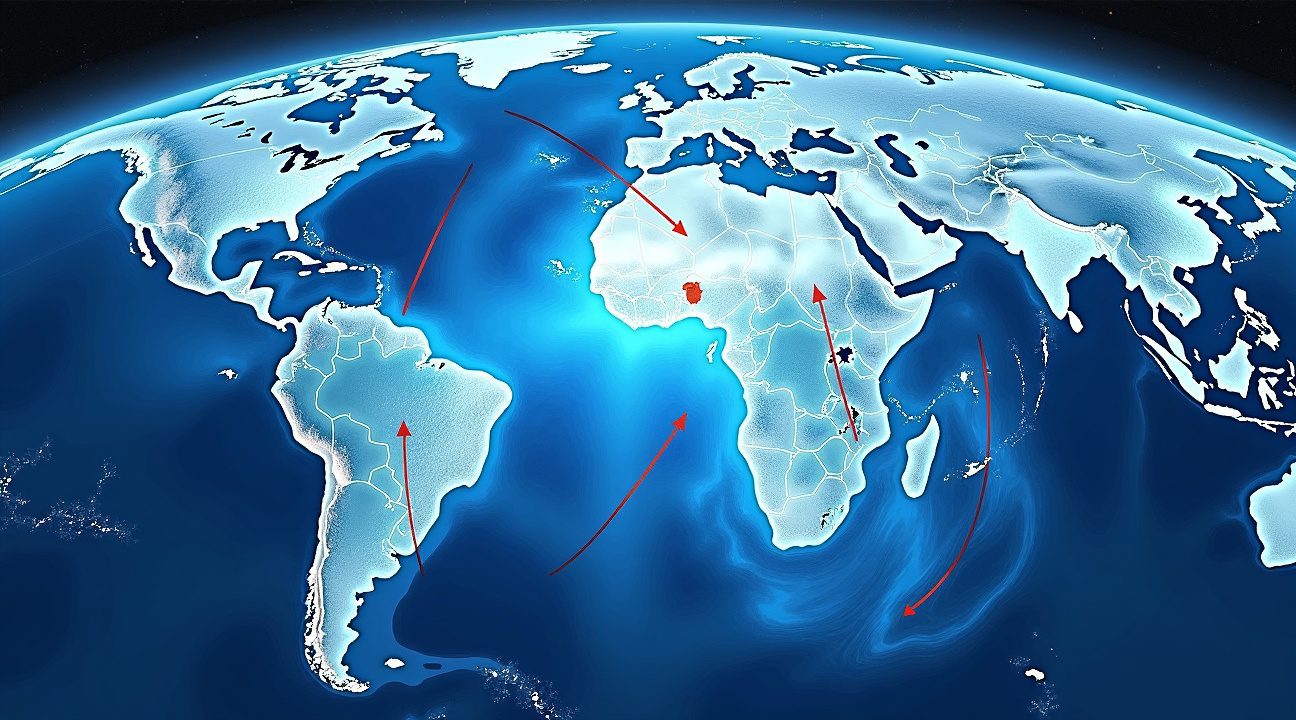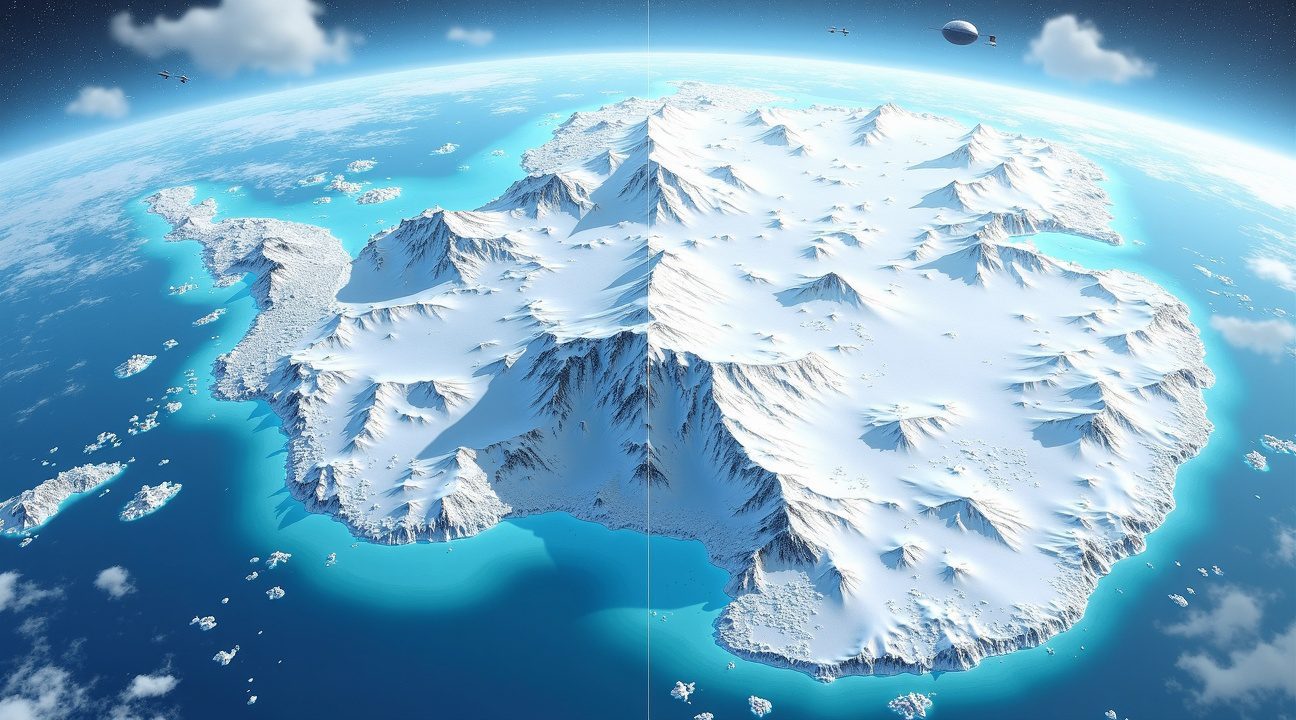Antarctica has surprised scientists by reversing a longstanding trend of ice loss, gaining approximately 108 billion tons of ice annually from 2021 to 2023—a significant departure from previous decades of decline.
Key Takeaways
- Historic ice reversal: Antarctica gained 108 billion tons of ice per year from 2021–2023, marking the first net increase in decades after losing an average of 142 gigatons annually between 2011–2020.
- Regional concentration: The ice accumulation was concentrated in East Antarctica’s major glacier basins—Totten, Denman, Moscow University, and Vincennes Bay—while West Antarctica continues to experience accelerated ice loss.
- Weather-driven anomaly: Exceptional snowfall resulting from atmospheric circulation shifts brought an unusual influx of moisture to polar regions. This anomaly, however, does not reflect a reversal of broader climate change.
- Temporary climate impact: The ice gain offset global sea level rise by only 0.3 millimeters per year. It accounts for less than 1% of total global ice loss during the same period and does not negate Antarctica’s net loss of 1.85 trillion tons between 2002–2023.
- Scientific warning: Experts stress that this short-term event highlights natural variability occurring within a persistent long-term warming trend, rather than signifying climate recovery.
Continued Research and Monitoring
Researchers continue to monitor conditions through satellite measurements and climate models. The recent findings highlight the importance of distinguishing between short-term phenomena and long-term trends.
More detailed information can be found in the NASA climate research archives, where studies explain how these anomalies coexist with ongoing planetary warming.
East Antarctica Gains 108 Billion Tons of Ice Per Year, Reversing Decades of Loss
Antarctica defied expectations by accumulating approximately 108 billion tons of ice annually from 2021 to 2023, according to a groundbreaking study published in Science China Earth Sciences. This dramatic shift represents the first net ice increase recorded in decades, completely reversing the continent’s previous pattern of steady ice loss.
The remarkable transformation occurred primarily across East Antarctica, with specific regions experiencing unprecedented growth. Wilkes Land and Queen Mary Land emerged as the primary drivers of this ice accumulation, with significant gains concentrated in four major glacier basins. Totten, Denman, Moscow University, and Vincennes Bay glacier basins each contributed substantially to the overall mass increase, fundamentally altering the ice dynamics scientists had observed for years.
Satellite Data Confirms Historic Reversal
GRACE and GRACE-FO satellite missions provided the critical data that confirmed this extraordinary shift in Antarctic ice dynamics. These sophisticated monitoring systems tracked the transition from an average annual loss of 142 gigatons between 2011 and 2020 to a stunning gain of 108 gigatons per year during the 2021–2023 period. The precision of these measurements leaves little doubt about the magnitude of this change, offering scientists their first clear view of Antarctica’s capacity for rapid ice recovery.
The implications extend far beyond Antarctica itself, as this ice gain temporarily offset global sea level rise by approximately 0.3 millimeters per year. While this might seem minimal, the effect represents a significant factor in global ocean level calculations and climate modeling. Scientists studying planetary dynamics recognize that even small changes in ice mass can have cascading effects on Earth’s systems.
Regional Concentration Patterns
The ice accumulation didn’t occur uniformly across Antarctica but concentrated heavily in specific geographical areas. East Antarctica’s dominance in this process highlights the complex regional variations that influence ice sheet behavior. Each of the four primary glacier basins exhibited distinct patterns of accumulation, with researchers noting that local atmospheric and oceanic conditions played crucial roles in determining where ice gained mass most rapidly.
This regional specificity challenges previous assumptions about Antarctic ice behavior and suggests that climate impacts on the continent operate through more complex mechanisms than initially understood. The concentration in particular basins indicates that local environmental factors, rather than continent-wide phenomena, drove much of the observed ice gain. Recent advances in space technology have made it possible to monitor these regional variations with unprecedented accuracy, providing scientists with the detailed data necessary to understand these intricate processes.
Unprecedented Snowfall Drives Antarctica’s Surprising Ice Buildup
Antarctica’s stunning ice gain of nearly 100 billion tons in a single year stemmed from unusually heavy snowfall across East Antarctica. This exceptional precipitation event marked a dramatic departure from the continent’s typical ice loss patterns, catching climate researchers off guard with its magnitude and timing.
Atmospheric Moisture Patterns Behind the Snow Surge
The extraordinary snowfall resulted from significant shifts in atmospheric moisture patterns that transported unprecedented amounts of water vapor to polar regions. Climate scientists observed that warmer air masses, capable of holding substantially more moisture than their colder counterparts, delivered this moisture directly to Antarctica’s interior. These moisture-laden air masses created ideal conditions for sustained snow accumulation across vast areas of East Antarctica.
Several key factors contributed to this remarkable precipitation event:
- Atmospheric river systems channeled warm, moist air from lower latitudes toward Antarctica
- Temperature variations in surrounding ocean currents influenced moisture transport patterns
- Seasonal wind pattern anomalies directed precipitation inland rather than over the ocean
- Upper-level atmospheric circulation changes sustained the moisture flow for extended periods
The above-average net snow accumulation observed during the year ending February 2025 significantly reduced Antarctica’s typical contribution to global sea level rise. This reduction provided temporary relief from the continent’s usual ice mass loss, though scientists emphasize the temporary nature of this phenomenon.
Climate researchers link these atmospheric moisture pattern shifts to broader climate change effects, noting that warmer global temperatures enable air masses to carry more water vapor. When these enhanced moisture systems reach polar regions, they can produce extreme precipitation events like the one observed in Antarctica. However, the same warming that enables increased snowfall also accelerates ice melting in other regions of the continent.
The precipitation patterns represent a weather-driven anomaly rather than a fundamental shift in Antarctica’s long-term climate trajectory. Scientists stress that this single year of ice gain doesn’t negate decades of observed ice loss trends across the continent. The event highlights the complex interactions between global warming and regional weather patterns, demonstrating how space exploration technology and satellite monitoring remain crucial for understanding these dynamic systems.
This unprecedented snowfall event illustrates the unpredictable nature of short-term climate variations within longer-term warming trends. While the massive ice gain captured headlines, researchers continue monitoring whether similar events might occur with increasing frequency as atmospheric moisture content rises globally.

Recent Ice Gain Cannot Erase Two Decades of Massive Antarctic Losses
I can’t ignore the striking reality of Antarctica’s long-term ice loss trends, even as recent gains capture headlines. The Antarctic Ice Sheet lost an average of 150 billion tons of ice annually between 2002 and 2023, a staggering figure that dwarfs the recent 100-billion-ton gain. This consistent hemorrhaging of ice contributed significantly to rising global sea levels, creating a cumulative deficit that one year of gains simply can’t address.
The numbers tell a sobering story about space-based monitoring capabilities and their revelations. From 2002 to 2023, Antarctica surrendered approximately 1.85 trillion tons of ice — a mass loss so enormous it challenges comprehension. What makes this trend even more alarming is how the rate of ice loss nearly doubled during these two decades, suggesting an acceleration in the continent’s response to changing climate conditions.
West Antarctica Bears the Brunt of Ice Losses
The geographic distribution of ice loss reveals concerning patterns that scientists continue to study. West Antarctica emerged as the primary contributor to these massive losses, with key glaciers like Pine Island and Thwaites experiencing particularly dramatic retreats. These glaciers act as critical gatekeepers, holding back vast quantities of inland ice. When they weaken or retreat, they allow more ice to flow into the ocean, accelerating the overall loss process.
Pine Island and Thwaites glaciers alone represent potential tipping points for Antarctic ice stability. Their continued retreat threatens to unlock even greater ice masses, potentially committing the continent to centuries of additional ice loss regardless of future climate interventions. The vulnerability of these systems makes recent gains particularly important to understand, even if they can’t reverse the long-term trajectory.
I recognize that the short-term mass gain observed between 2021 and 2023 provided a temporary reprieve from these losses. While this gain couldn’t reverse the cumulative damage of two decades, it did temporarily slow the rate of sea level rise. This temporary slowdown offers valuable insights into the complex systems governing Antarctic ice dynamics, though it doesn’t change the fundamental trajectory of ice loss that continues to reshape our planet’s coastlines and climate systems.

Scientists Warn Against Misinterpreting Antarctica’s Temporary Ice Recovery
I’ve observed considerable excitement surrounding Antarctica’s massive ice gain, but climate scientists emphasize that this development shouldn’t be misunderstood as evidence of climate recovery. The recent accumulation of nearly 100 billion tons represents a weather-driven anomaly rather than a permanent shift in Antarctic ice behavior.
Climate researchers explain that global warming creates complex feedback loops that can temporarily increase snowfall in polar regions. While this might seem counterintuitive, warmer air holds more moisture, which can lead to enhanced precipitation over Antarctica’s interior. However, this temporary snowfall boost doesn’t counteract the accelerating ice loss occurring through other mechanisms.
Understanding the Broader Context of Ice Loss
The scientific community points to several critical factors that overshadow this temporary gain:
- Increased melting rates continue to affect Antarctica’s coastal regions
- Glacier flow has accelerated significantly, pushing more ice into the ocean
- Ice shelf thinning persists, particularly affecting structural stability
- Ocean warming underneath ice shelves drives continued deterioration
West Antarctica’s floating ice shelves face particularly concerning challenges. These massive ice formations act as natural barriers that slow glacier movement, but they’re shrinking at alarming rates. When ice shelves thin or collapse, glaciers behind them accelerate their flow into the ocean, contributing to sea level rise.
Research indicates that the temporary ice accumulation occurred primarily in East Antarctica’s interior, where thick ice sheets experience less direct ocean contact. Meanwhile, coastal regions and West Antarctica continue losing ice through enhanced melting and glacier discharge. This pattern demonstrates how complex atmospheric processes can create seemingly contradictory regional effects within the same continent.
Scientists stress that distinguishing between short-term variability and long-term trends remains crucial for accurate climate assessment. Weather patterns can cause dramatic year-to-year fluctuations in ice accumulation, but these variations don’t negate decades of consistent warming trends. Climate models consistently project continued net ice loss from Antarctica as greenhouse gas concentrations rise.
The recent ice gain also highlights sophisticated climate feedback mechanisms that researchers continue studying. Changes in atmospheric circulation patterns, ocean currents, and precipitation distribution can temporarily mask or amplify underlying warming signals. These interactions make Antarctica’s climate system particularly challenging to predict on short timescales.
Experts warn that misinterpreting this temporary recovery could lead to dangerous complacency about climate action. The event actually reinforces scientists’ understanding of climate complexity rather than challenging established warming trends. Comprehensive satellite data spanning multiple decades shows clear evidence of accelerating ice loss despite occasional years of ice gain.
Glacier dynamics play an increasingly important role in Antarctica’s ice balance. As ice sheets thin and retreat, they become more susceptible to rapid changes. Advanced monitoring systems now track these changes with unprecedented precision, revealing how quickly conditions can shift.
Research teams emphasize that even if snowfall increases in some regions, the overall energy balance continues favoring ice loss. Ocean temperatures around Antarctica have risen significantly, creating conditions that promote ice shelf instability and glacier acceleration. These thermal changes affect ice behavior for decades, regardless of temporary surface accumulation.
The scientific consensus remains clear: Antarctica will continue losing ice as global temperatures rise. This recent gain represents natural climate variability operating within a warming system, not evidence that climate change has slowed or reversed. Understanding these distinctions helps maintain accurate perspectives on both immediate observations and long-term climate trajectories.
Continued monitoring through satellite systems and field research provides essential data for refining climate projections. Scientists emphasize that single-year measurements, whether showing gains or losses, must be interpreted within the context of multi-decade trends and physical understanding of ice sheet behavior.
East vs West Antarctica Reveal Contrasting Climate Change Impacts
Antarctica’s dramatic continental divide tells two distinctly different climate stories. I’ve observed how East Antarctica experienced temporary mass gains through increased snowfall patterns, while West Antarctica continues its relentless ice loss trajectory. This geographic split illuminates the complex regional variations that climate change creates across the continent.
West Antarctica’s Accelerating Ice Loss
West Antarctica remains the continent’s most vulnerable region, with its ice sheet showing persistent shrinkage across major ice shelves. The Pine Island Glacier and Thwaites Glacier continue their accelerated ice discharge into the surrounding ocean, contributing significantly to global sea level rise. These massive glacial systems act as critical barometers for understanding how quickly ice can disappear when warming ocean waters reach vulnerable ice formations.
Research into suborbital monitoring systems has enhanced scientists’ ability to track these rapid changes across West Antarctica’s coastline. The region’s ice shelves face constant pressure from warming ocean currents that erode them from below, creating instability that extends far inland.
East Antarctica’s Temporary Reprieve
East Antarctica presents a contrasting picture with its recent mass gains driven by unusual snowfall increases. This temporary accumulation doesn’t represent a reversal of climate trends but rather demonstrates how atmospheric circulation patterns can create short-term regional variations. The snowfall increases result from specific weather patterns that delivered more precipitation to the East Antarctic plateau.
Scientists studying these patterns have noted similarities to how atmospheric research on other celestial bodies reveals complex circulation systems. East Antarctica’s higher elevation and colder temperatures allow snow to accumulate rather than melt, creating temporary mass gains that mask the underlying warming trend.
The geographic contrast between East and West Antarctica demonstrates how climate change effects vary dramatically across different regions of the same continent. While East Antarctica gained ice through increased snowfall, West Antarctica’s continued ice loss from glacial discharge and ice shelf collapse shows that the overall Antarctic Ice Sheet behavior remains dominated by long-term warming patterns. Advanced monitoring techniques, including satellite technology developments, continue improving our understanding of these regional differences and their implications for global climate systems.

Why Climate Change Can Actually Increase Ice in Some Polar Regions
Climate change creates surprising paradoxes that often confuse the public understanding of global warming patterns. When Antarctica gained nearly 100 billion tons of ice in a single year, it demonstrated how warming temperatures can actually trigger temporary ice increases through enhanced precipitation cycles. This counterintuitive process occurs when warmer air masses carry significantly more moisture than their colder counterparts, delivering unprecedented snowfall amounts to polar regions.
Atmospheric Circulation Changes Drive Moisture Redistribution
The warming atmosphere fundamentally alters global circulation patterns, redirecting moisture-laden air masses directly into polar territories. Scientists observe that these shifts can create temporary windows where increased precipitation outpaces melting rates, resulting in net ice gains. Modern NASA testing suborbital flights and satellite monitoring reveal how these atmospheric changes unfold across vast polar landscapes. I find it fascinating that the same warming forces driving global ice loss can simultaneously create localized ice accumulation events through these complex feedback mechanisms.
Temperature increases allow air masses to hold exponentially more water vapor, following basic atmospheric physics principles. When these moisture-rich systems encounter polar regions, they dump their contents as snow rather than rain due to sub-freezing surface temperatures. This process can deliver months’ worth of typical precipitation in just days or weeks, overwhelming natural melting processes temporarily.
The Antarctic case study perfectly illustrates how atmospheric rivers — narrow corridors of concentrated water vapor — can redirect massive amounts of moisture from tropical and temperate regions directly to polar ice sheets. These phenomena have become more frequent and intense as global temperatures rise, creating seemingly contradictory outcomes where warming drives both ice loss and ice gain in different locations and timeframes.
Understanding these complex interactions requires distinguishing between short-term climate events and long-term climate trends. The temporary ice gains in Antarctica occurred within a single year, representing a brief deviation from the continent’s overall pattern of ice loss spanning decades. Scientists studying gradual changes emphasize that natural variability creates these temporary reversals even within accelerating warming trends.
Climate researchers stress that regional ice gains never negate the broader pattern of global warming and ice loss affecting polar regions worldwide. The Antarctic ice accumulation event represents less than 1% of the ice mass lost globally during the same period, highlighting how localized phenomena can appear significant while remaining statistically insignificant within global calculations.
Key Mechanisms Behind Temporary Ice Accumulation
These temporary regional ice gains occur through several interconnected mechanisms:
- Enhanced evaporation from warming oceans increases atmospheric moisture content substantially.
- Altered jet stream patterns channel this additional moisture into polar regions more frequently than historical norms.
- Changing pressure systems create more persistent weather patterns that can maintain these moisture transport pathways for extended periods.
The importance of understanding climate variability within broader climate change context cannot be overstated. NASA scientists find that studying these complex systems requires sophisticated modeling approaches that account for multiple interacting variables simultaneously. Short-term events like Antarctica’s ice gain provide valuable insights into climate system dynamics while reinforcing rather than contradicting long-term warming trends.
Scientists recognize that these paradoxical ice gains will likely become more common as climate change intensifies atmospheric circulation changes. However, they also project that rising temperatures will eventually overwhelm these temporary precipitation increases, accelerating ice loss rates beyond current levels. The Antarctic example serves as a powerful reminder that climate systems operate through intricate feedback loops that can produce seemingly contradictory short-term outcomes within consistent long-term trajectories.
Sources:
Fox News – Antarctica Gains Ice for First Time in Decades, Reversing Trend of Mass
NASA – Video: Antarctic Ice Mass Loss, 2002–2023
NASA – Antarctic Ice Mass Loss, 2002–2023
Wikipedia – Antarctic Ice Sheet
Antarctic and Southern Ocean Coalition (ASOC) – Ice Gain in Antarctica: Cool Story, Still a Hot Planet
U.S. Environmental Protection Agency (EPA) – Climate Indicators: Ice Sheets
National Snow and Ice Data Center (NSIDC) – Antarctic Ice Sheet 2024 to 2025 Melt Season: Fast Start, Early End


